Our aftermarket vision is simple: Be our customers’ frst choice for aircraft service and support and we’re doing the work to earn their
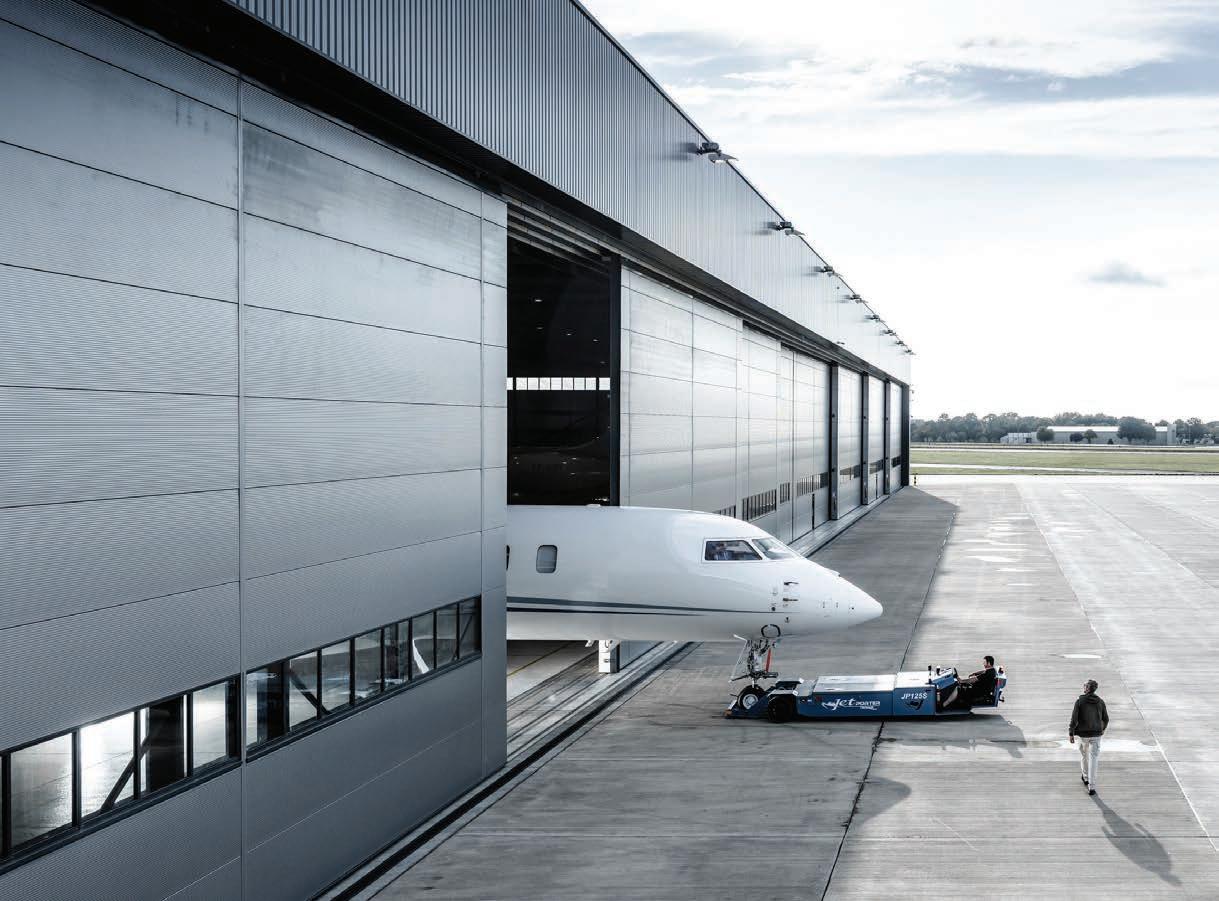
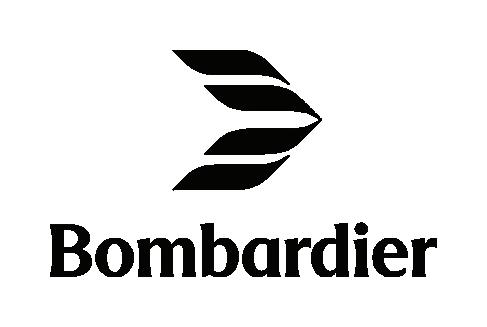

Our aftermarket vision is simple: Be our customers’ frst choice for aircraft service and support and we’re doing the work to earn their





EBAA chief
Holger Krahmer
By Charles Alcock
Stakeholder discussions at EBACE 2025 are expected to resolve the location and format of future shows, with organizer EBAA expected to announce its plans on June 30. It seems increasingly likely that the EBACE event this week at PalExpo will be the last to be staged in Geneva.
Besides Geneva, seven other European cities are now in contention to be EBACE’s future home: Barcelona, Frankfurt, Vienna, Dublin, Milan, Paris, and London. In addition, EBAA said it is also considering how it could revive the show’s aircraft static display, which was dropped from this year’s format due to a lack of support from aircraft manufacturers and brokers.
EBAA officials are also trying to resolve how they can attract increased numbers of high-net-worth individuals to the show, as well as providing new options for exhibitors and an “appropriate pricing strategy” for them and attendees alike. Further, the association has declared itself to be open to possible partnerships with other show organizers.
“Since EBAA took over the running of EBACE in late 2024 [after NBAA withdrew support], we have been listening to and consulting with stakeholders across the industry on what they would most value in future EBACE events,” said the Brussels-based group’s secretary general, Holger Krahmer.
continues on page 22
TAXES
Schemes threaten Euro bizav viability
Government money grabs target business aviation | 10
SUSTAINABILITY
RefuelEU rules sow confusion
Business aircraft operators perplexed by EU SAF mandate applicability | 18
IBAC, Dyami team Dyami offers bizav security training under IBAC partnership | 8
MAINTENANCE
AMAC grows
Basel-based aircraft MRO and completions company acquires cabin design firm | 17 alerts


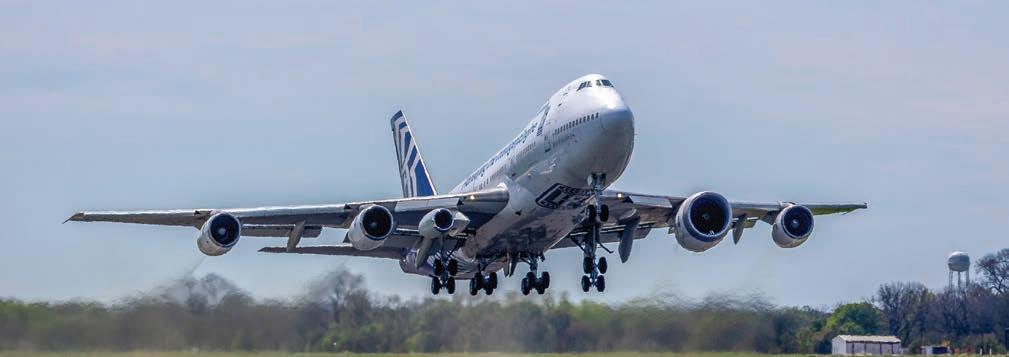
By Kerry Lynch
Celebrating the 9,000th engine produced at its Dahlewitz site, Rolls-Royce continued to progress on its newest engine model, the Pearl 10X, accruing 3,400 test hours in the program.
Slated for Dassault Aviation’s ultra-longrange Falcon 10X, the Pearl namesake has successfully completed all but one major engine certification test, Rolls-Royce reported. These have covered initial maintenance interval, type test, medium bird strike, outdoor crosswind, and emissions. Remaining trials are scheduled in the coming months in support of Dassault’s upcoming Falcon 10X flight-test campaign.
Rolls-Royce said its tests have demonstrated the maturity of the engine. “Each achieved milestone in the Pearl 10X development program so far reflects the hard work and dedication of our global engineering and experimental test teams,” said Phillip Zeller, senior v-p of Rolls-Royce. “As we approach the final certification tasks, we are confident the Pearl 10X will meet the highest standards of performance, efficiency, and reliability, ensuring it is the perfect fit for Dassault’s Falcon 10X.”
Collectively, Rolls-Royce’s Advance2 demonstrator and Pearl 10X engine configuration have amassed the test hours. They have included a comprehensive flight-test campaign
on Rolls-Royce’s Boeing 747 flying testbed in Tucson, Arizona. That campaign involved more than 25 flights and 36,000 nm over six months.
The company opened a 2,000-sq-m (21,500sq-ft) production support facility in Le Haillan, France, near Dassault’s final assembly line in Merignac, to support the flight test and production activities for the Falcon 10X. This RollsRoyce facility houses offices, a workshop, and a warehouse, with 30 employees on site.
Combining Rolls-Royce’s Advance2 core with a high-performance low-pressure system, the Pearl 10X will produce a thrust of more than 18,000 pounds, placing it among the most powerful of its business engine models.
Key features included a blisked fan, high-pressure compressor with six blisked stages, ultra-low emissions ALM combustor, two-stage shroudless high-pressure turbine, and an enhanced four-stage low-pressure turbine, and a tailored nacelle from Spirit AeroSystems. The engine is 5% more efficient than previous BR700-series engines and can run on 100% sustainable aviation fuel.
Meanwhile, as the Rolls-Royce approaches approval for its latest engine model, it celebrated the 9,000th engine produced at its Dahlewitz site. That milestone engine, the
Rolls-Royce conducted flight trials of its Pearl 10X on the company’s 747200 flying testbed in Tucson, Arizona.
Pearl 700, powers the Gulfstream G700.
Located south of Berlin, the plant began production in June 1995 and has since grown into a center of excellence for two shaft engines. The site employs 2,400 people from 60 nations.
The headquarters for Rolls-Royce’s business aviation operations, the facility develops, manufactures, and maintains engines. RollsRoyce said the facility is playing a pivotal role in its strategy to grow its market share.
Engines produced in Dahlewitz include the Pearl 10X, Pearl 15, Pearl 700, BR710, BR715, BR725, Tay 611-8/-8C, V2500, and Trent XWB84. More than 6,100 of those produced are powering business aircraft. Additionally, Dahlewitz is home to Rolls-Royce’s UltraFan demonstrator program.
“Dahlewitz is a cornerstone of the company’s future ambitions, and I’m already looking forward to the 10,000th delivery,” said Dirk Geisinger, chairman of Rolls-Royce Deutschland. “With our growing installed base, our market-leading Pearl engine family, and our increasing market share in the ultra-longrange business aviation segment, we are ideally positioned for future growth, helping to transform Rolls-Royce into a high-performing, competitive, resilient, and growing business.”
To that end, the company said it anticipates a 7% to 9% increase in Rolls-Royce-powered aircraft in service for the remainder of the decade and believes flying hours will reach 120% to 130% of the 2019 levels in the short term.
Rolls-Royce has announced plans for a £30 million ($35.8 million) investment in the site and expects to recruit 100 more employees to support services for Trent 1000 engines. z



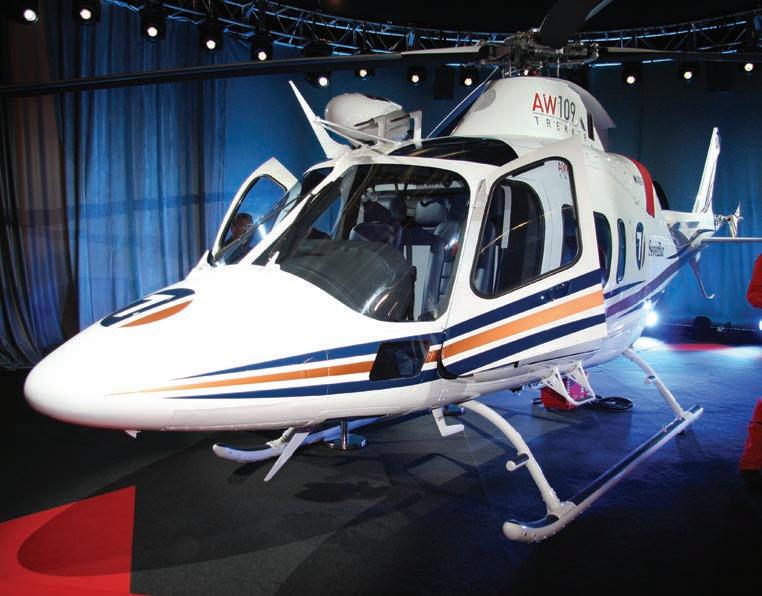
By Charles Alcock
Leonardo is capitalizing on rising demand for corporate and VIP helicopters, with multiple orders set to be announced this week at EBACE 2025. Contract signings are anticipated for at least two models and from customers in Europe and Asia
The Italian group is the only aircraft manufacturer exhibiting at this year’s new-format EBACE show in Geneva, where it is displaying an example of the AW139 Trekker multirole helicopter on the convention show floor. It is seeing healthy demand for its AW139 and AW169, with all models having been boosted by the relaunch of its Agusta VIP helicopter brand in 2021. Leonardo is also marketing the 30th anniversary of its partnership with UK and Ireland distributor Sloane Helicopters this month.
According to Leonardo VVIP and corporate unit senior sales and marketing manager Manuela Barbarossa, orders in this sector have been increasing over the past five or six
years. “The market is reacting significantly to the need for individuals and businesses to have point-to-point travel connections,” she told AIN
Increasingly, customers are viewing helicopters not just as a transportation tool but as a good investment asset, Barbarossa explained, adding. “When they are not using the aircraft themselves, they can let an operator use it for charter flights and this attracts a new generation of customers who may charter first and then convert to ownership later.”
This shared-use model which offsets some of the cost of helicopter ownership is more fiscally viable in some countries than others. Lately, Leonardo has seen the strongest European demand in the UK, and other markets seeing growth include Mexico, South America, northeast Asia, India, and the Middle East.
In Leonardo’s experience, customers buying helicopters for personal use tend to be the most demanding because they view the
aircraft as an extension of their lifestyle, and sometimes bring family groups to the manufacturer to specify cabin interiors and other features. Around half of current sales fall into this category for the manufacturer, with most of the rest being a mix of charter, utility, and cargo roles.
To help clients define the look and feel of their helicopters, Leonardo’s design team has introduced “mood boxes” that present multiple options for interior materials and colors. These can be viewed this week at Leonardo’s EBACE exhibit, along with cabin mockups developed to reflect the mood of cities including Florence, Italy; Fortaleza, Brazil; Tokyo; London; and New York.
Meanwhile, to help ensure that operating costs are predictable for customers, Leonardo provides its Agusta For You service packages that cover all scheduled and unscheduled maintenance. “It covers everything, and for the AW139 includes avionics, so there are no surprises and all costs are fully defined,” Barbarossa said. z

With FlightSafety International, you’re not just checking regulatory boxes. You’re pioneering a new standard of excellence in aviation–using data analysis to train more e ectively for the right safety risk areas. In fact, those who train with us are 12x more likely to avoid an incident or accident. Visit us at Booth 1677
By Kerry Lynch
The International Business Aviation Council (IBAC) is rolling out the Core Risk Management platform this week at 2025 EBACE to help provide smaller aviation businesses with a framework for safety processes.
Targeted at operators, ground-handling services, aircraft maintenance operations, and small airports, the Core program provides a self-paced online platform with tools and methods to help organize a company’s existing risk management processes and help identify gaps.
“Our member associations have felt strongly about the need for a simple, flexible risk management tool for their members, which was endorsed by the IBAC governing board this week,” said IBAC director general Kurt Edwards. “Many smaller organizations within the business aviation industry want to build a stronger foundation for managing safety, but may be challenged by limitations of time and resources for non-core risks.”
Core was designed as a resource for those looking to either establish or improve existing safety practices and processes, he added.
Besides adding services, IBAC is expanding its reach, signing up its first industry partner in Latin America, as well as its first UK-based operations affiliate. Brazilian-based aviation services provider SynerJet joined the Industry Partner Program (IPP), as did UK-based flight-planning specialist Echo3.
They joined 20 other organizations in the IPP program that collaborate with IBAC’s 15 member associations and secretariat on key business aviation issues. “There are many challenges and opportunities in our industry, and we feel it is important to provide strong support and get involved in IBAC’s mission,” said SynerJet’s Adalberto Febeliano.
James Wiskin, Echo3 operations specialist, added, “We are excited to be part of IBAC and look forward to supporting its global mission for business aviation.”
Also this week, IBAC recognized TrainingPort founder and president Scott Macpherson with its DG (directional gyroscope) Award for his
“exceptional and strategic contributions to IBAC and the global business aviation community.”
Macpherson has served on the IBAC Governing Board since 2012 as the representative of the Canadian Business Aviation Association, holding roles as vice chair, chair, and immediate past chair.
“IBAC and the global business aviation community have benefited greatly from Scott Macpherson’s profound contributions,” said IBAC governing board chairman Ali Alnaqbi in presenting the award. “It has been a privilege
to work with and learn from Scott. He has not only shared his keen insight of the industry with me and the IBAC organization, but he has helped steer IBAC and its programs to grow and better serve the industry.”
MacPherson has a 30-year background as a pilot and manager in corporate aviation, most recently flying a Dassault Falcon 900LX. His flight department was the first registered operator under the International Standard for Business Aircraft Operations (IS-BAO) program. z
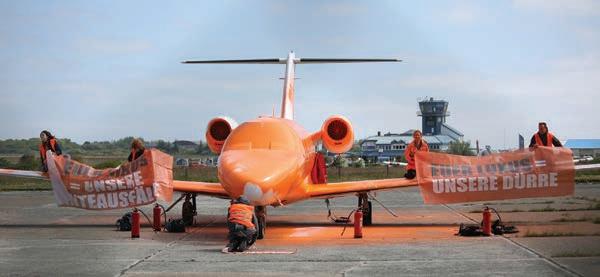
Dynami’s security training program helps operators prepare for scenarios such as activist protests.
With threats proliferating in conflict zones around the world, Netherlands-based Dyami Security Intelligence is supporting IBAC in launching a security training program specifically developed for business aircraft operators. The company’s Dyami Academy will provide security and resilience training. The service is based on a virtual reality (VR) safety and emergency response training program for both flight crews and ground sta , o ering clients a more cost e ective approach.
Based on the Edumersive VR platform already deployed in the maritime industry, the training includes realistic 360-degree video-based simulations of scenarios such as inflight emergencies, activist protests, and other security incidents.
“Technology has finally caught up with
the demands of modern aviation safety,” said Dyami Academy COO Charlotte Bakker. “With Edumersive and our aviation training experience, we can o er airlines, aircraft operators and aviation training institutions an engaging, scalable, and cost-e ective alternative to traditional training methods, without compromising realism.”
Meanwhile, tomorrow at 3.15 p.m., Dyami founder and CEO Eric Schouten will lead an EBACE conference session on security with Simon Evers, corporate aviation manager at Shell Aircraft. Under the title “Navigating the Chaos—Conflict Zones, GPS Spoofing, and the Future of Safe Operations,” the experts will explore the rapidly-evolving threat landscape and how aircraft operators can respond. C.A.


The AW169 o ers more than just transport - it’s a reflection of your unique lifestyle.
With seamless performance and bespoke design, it e ortlessly takes you to your destination in comfort and speed.
Step into the bright and spacious cabin and enjoy your favourite entertainment in a welcoming atmosphere.
Let every flight experience be a moment of connection with your loved ones and appreciate the view from the sky.
Visit us at EBACE, Stand n°784
By Charlotte Bailey
As European governments grapple with budgetary deficits and pressure to achieve net-zero carbon targets, taxation is being weaponized to make business aviation pay, according to industry organizations. Over the past 12 months, industry leaders are increasingly concerned about the way the sector has been singled out for an “all-stick-no-carrot” approach to market manipulation at a time when Europe’s anemic economies have arguably never been in greater need of the wealth generation that business aircraft can support.
France’s so-called “solidarity tax,” which has been imposed on private charter services since March 1, is the most glaring case of the aggressive fiscal pressure that some see as posing an existential threat to business aviation in that country. Pending increases to the UK’s air passenger duties are another example, and while both sets of taxes also apply to airline passengers, there is an intentionally disproportionate impact on business aviation travelers.
The impact of the new French tax varies according to a flight’s destination category and the aircraft booked. This can result in charges ranging from €210 to €2,100 per passenger and represents a jump of up to 300% from previous taxes.
According to Kyle Martin, v-p of European affairs with the General Aviation Manufacturers Association (GAMA), France’s levy is “the biggest and most frustrating tax development” in Europe and poses a serious threat to commercial charter operators. In his view, it is no more than a “punitive revenue-driving measure for the French government.”
The tax was conceived last year as part of plans to plug a serious budget deficit at a time of extreme uncertainty over the stability of France’s government. According to Martin,
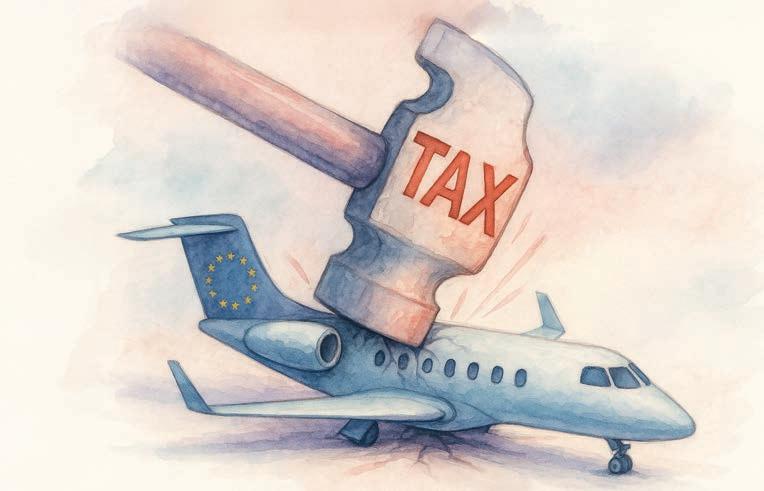
Punitive taxes on business aviation in Europe and the UK threaten to unravel decades of progress.
business aviation emerged as “an easy target” despite France being a long-standing aviation industry leader.
“It’s somewhat surprising the French government chooses to attack aviation this way with this punitive tax measure,” he told AIN. Notably, politicians behind the solidarity tax have not sought to justify it as part of a decarbonization effort, even though sustainability has previously been used as the main driver of fiscal moves against the industry. The implication would appear to be that the coalition that instigated the tax as part of a highly contentious 2025 budget settlement in France’s fragmented parliament viewed it as a wealth dispersal measure.
“We should move away from the ban mentality and focus on policies that support innovation, decarbonization, and competitiveness,” said Holger Krahmer, secretary general of the European Business Aviation Association (EBAA).
According to Olivier Perdriel, CEO of Paris-based aircraft management and charter group Skyfirst, the solidarity tax could have
disastrous economic and social repercussions “that are likely to cost France more than it will earn.” He predicted it could force some aircraft operators out of business and also compromise the viability of many smaller regional airports across the country that play a vital role in transport services, including medical evacuation flights.
Across the channel, the UK government is set to turn up the fiscal dial on private aviation with new passenger duty rates that took effect in April and include a new top rate of £673 ($895) per passenger. This is set to increase even more to more than £1,000 from April 2026 for larger jets, with the UK government maintaining that “this increase to the higher rate will ensure that users of private jets continue to make a fair contribution to the public finances.”
None of the anticipated £520 million expected income in the first financial year alone is to be allocated to environmental sustainability measures.
While the rationale behind elevated taxation on private aviation seems to be consistent, it’s
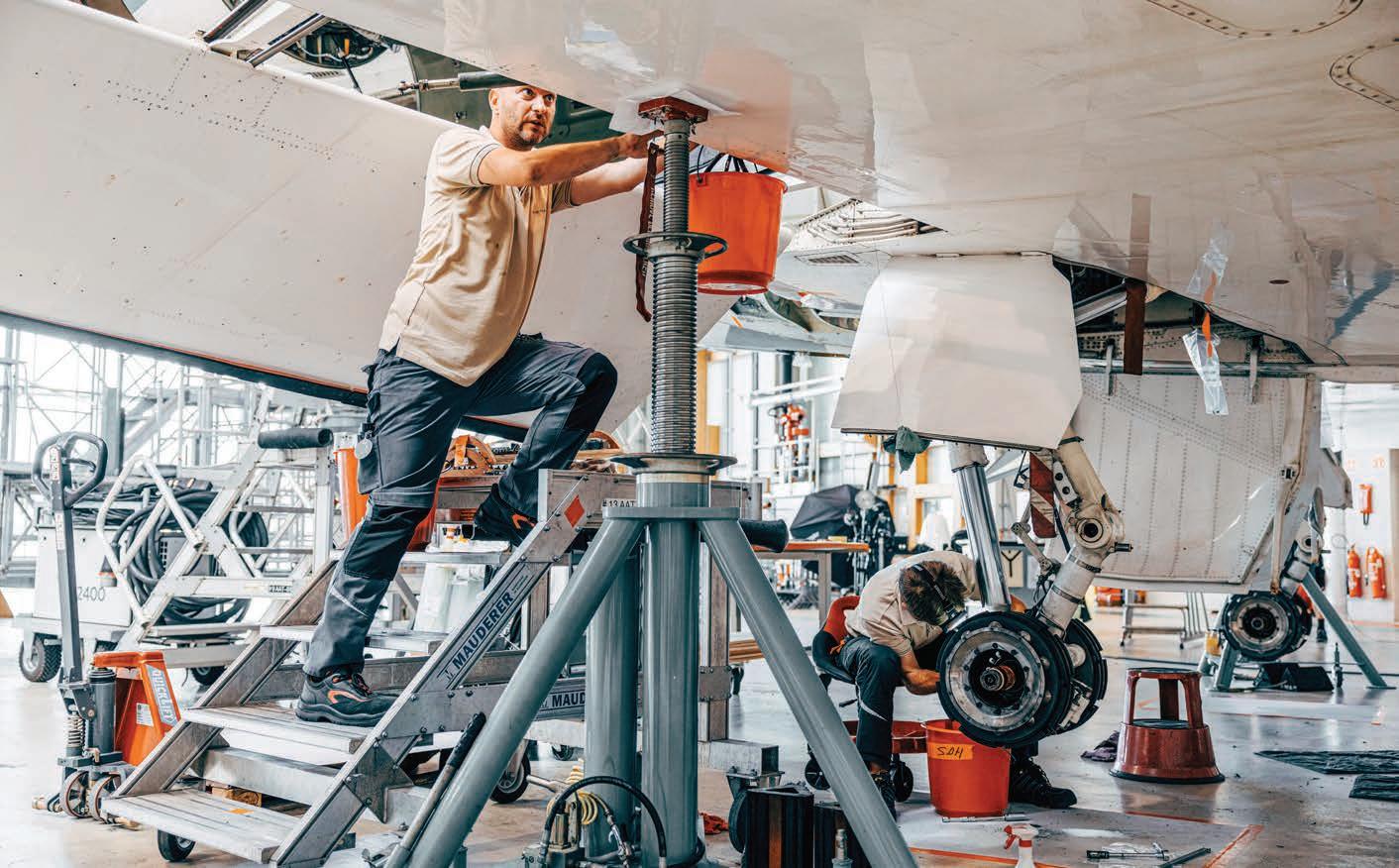
perhaps no wonder that EBAA describes the European fiscal regime as “highly fragmented, with many different taxes being applied differently in various European member states.” Italy first imposed a tax on private and business aviation (the “Salva Italia” or “Aerotaxi tax”) in 2012, while Belgium’s “embarkation tax” (just €2 to €10 per passenger) came into effect in 2022.
An Oxford Economics study commissioned by GAMA and EBAA and published in January warned that “restrictive government policies” could jeopardize up to €120 billion ($136 billion) in foreign investments and 104,000 jobs by 2030.
“Often perceived as a luxury, business aviation plays a crucial role in economic deployment,” said Carlos Brana, senior executive v-p for civil aircraft at Dassault Aviation. “We’ve seen firsthand how it fosters growth in the regions it connects, from creating jobs in remote areas to attracting investment and reducing travel time.”
Nonetheless, there is a sliver of a silver lining alongside Europe’s darker fiscal clouds, with Sweden—described by IATA as a nation to have “notably lagged its neighbors” in post-pandemic aviation recovery—set to abolish its air passenger duty.
“Sweden, and to an extent Norway and Denmark, they’re all trying to incentivize,
By Charles Alcock
The Air Charter Association (ACA) is hosting its annual Air Charter Forum conference as part of this year’s EBACE show. This will run from 1:30 p.m. to 4:15 p.m. on Wednesday, May 21 on the Innovation & Sustainability Stage. Additionally, the industry group will hold its annual networking event for members on May 20 from 6 p.m. to 9 p.m. in Geneva. Across three sessions, speakers will address the state of the charter market and the role of brokers, as well as provide some training through
an interactive quiz to test industry knowledge led by ACA training manager Julie Ellis and chief executive Glenn Hogben. Winners of the quiz, which starts at 3:30 p.m., will receive a pair of tickets to attend ACA’s Air Charter Excellence Awards Gala Dinner in November.
The opening session will begin with the latest market data from WingX managing director Richard Koe. A discussion about whether air charter is growing or shrinking will include contributions from industry leaders including MaceAero CEO Chris Mace; FlyingGroup’s director of sales, Matthieu Dardenne; Saxon
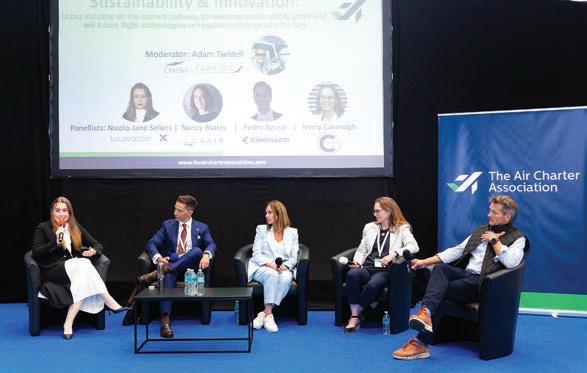
The Air Charter Association’s annual Air Charter Forum addresses industry topics such as market conditions, sustainability, safety, and training.
fund, develop, and encourage future propulsion technologies, particularly for their regional flights. So they’re trying to do that by incentivising regional operators and not taxing them,” GAMA’s Martin explained.
Dassault, with support from EBAA, has mounted an unsuccessful legal challenge against the European Commission’s so-called European Union Taxonomy legislation, which effectively excludes business aviation from accessing finance associated with sustainability measures, such as fleet replacement and investment in sustainable aviation fuel. Nonetheless, Martin stressed that the business aviation industry groups must continue to press for fairer treatment from governments. z
Air CEO Alex Durand; Andy Jurd, senior v-p for private jets with Air Partner; and Roberto Zapatero, commercial and business development director at Gestair.
The discussion about the evolving role of charter brokers will be led by Julie Black, head of UK executive charter at Hunt & Palmer. Other panelists will include Yann-Guillaume Jaccard, CEO and co-founder of Simply Jet; Robert Plhak, CEO at VOO Flights; Tomás Camprubí, managing director UK with LunaJets; and James Shotton, co-founder of Skytime.
“ACA is delighted to be able to support the revised EBACE 2025 format by hosting an afternoon of air charter-focused conference sessions,” said the association’s chairman, Kevin Ducksbury. “We always receive fantastic feedback from members who attend our annual ACA Forum events, and we believe it is an excellent platform for discussion that will add additional value to this year’s EBACE show.”
Since it rebranded from the Baltic Air Charter Association during its 70th anniversary in 2019, ACA has seen a near doubling of its membership. This steady growth since the global pandemic is demonstrating the key role that charter is playing in Europe, according to Hogben.
Founded as the Airbrokers’ Association in 1949 by members of the Baltic Mercantile and Shipping Exchange, the organization is picking up members at a rate of between six and seven a month and is poised to reach 500 this year. z
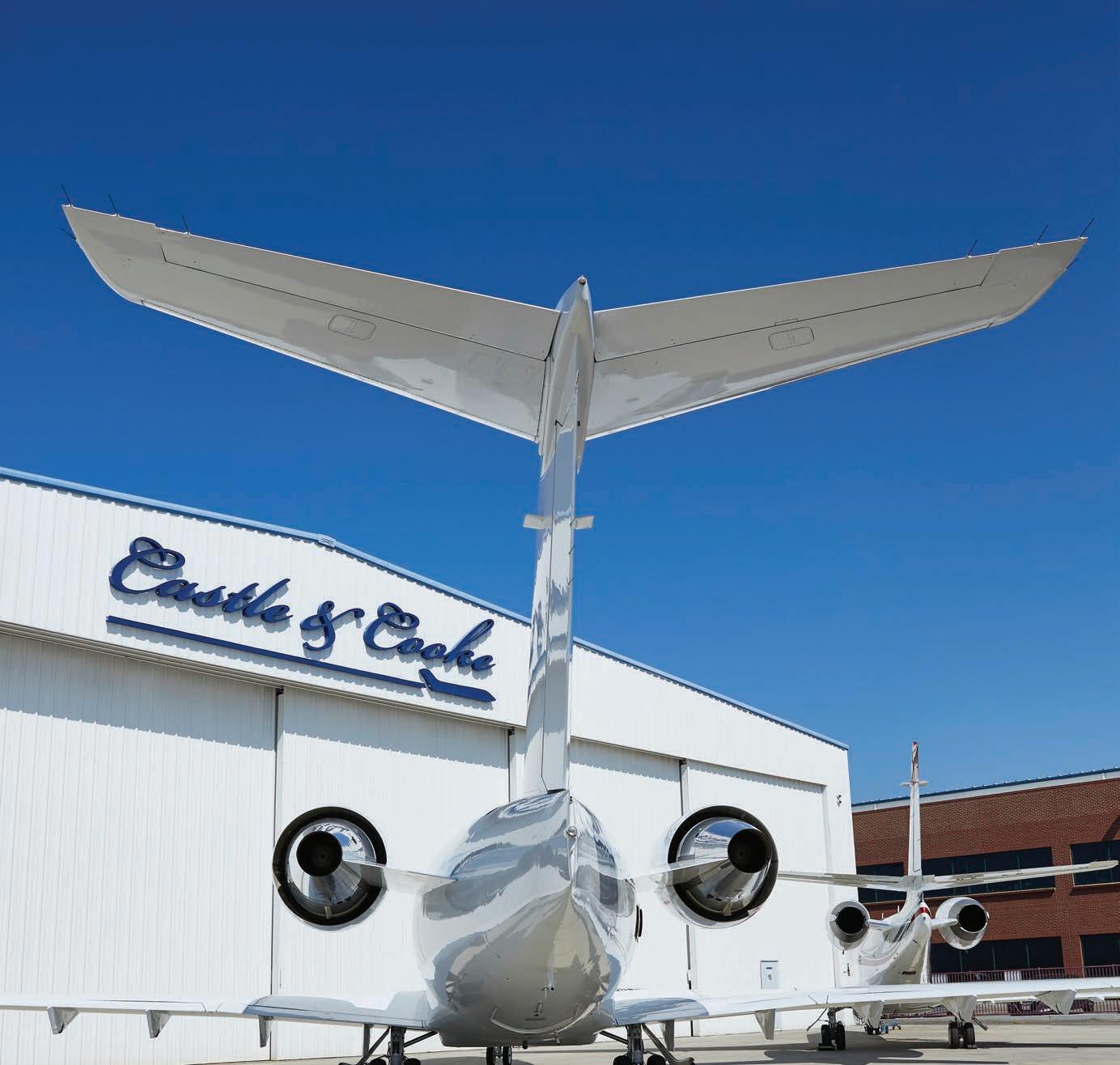

By Kerry Lynch
Germany-based Aero-Dienst signed a framework agreement with Dallas-based Engine Assurance Program (EAP) for engine and APU maintenance in Europe. Under the collaboration, Aero-Dienst will initially focus on providing European support for EAP-covered Honeywell TFE731 engines, but powerplants from other manufacturers will be added gradually, the companies said.
Services covered include AOG support, mobile response team (MRT) support, and engine repairs, along with unscheduled and scheduled maintenance at Aero-Dienst’s Engine Shop in Nuremberg. This includes
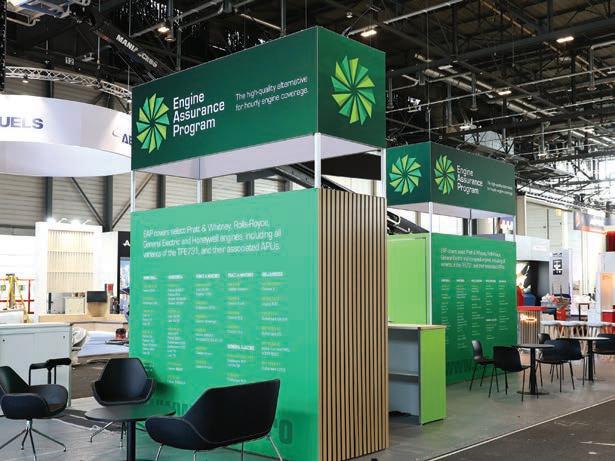
scheduled major period inspections.
“Our engine team is keen to provide the best possible support for EAP-covered engines in our region,” said Andrea Weyrich, maintenance engine shop manager at Aero-Dienst. The company has provided support for more than 800 Honeywell and Pratt & Whitney Canada turbine engines, she noted.
“Currently, 30% of all Learjets operated in Germany are enrolled on an EAP engine program,” said EAP managing director Sean Lynch, adding the partnership with AeroDienst helps it maintain its goal of providing rapid response to client requests.
Textron Aviation on Thursday completed the first flight of a second Cessna Citation CJ4 Gen3 test aircraft, marking a key milestone in the program’s path toward certification. Designated P1, the second test jet provides a platform focused on evaluating avionics, human factors, and cabin systems. The flight, conducted from the company’s Wichita facilities, lasted 3 hours 29 minutes and reached FL450 and 305 knots.
Pilots James Bearman and Corey Eckhart flew P1, concentrating on general systems evaluations and performance of the nextgeneration Garmin G3000 Prime avionics suite. Bearman said the aircraft performed
smoothly and met program expectations.
The CJ4 Gen3 was unveiled at NBAA-BACE 2024 and is expected to enter service in 2026.
The first prototype completed its inaugural flight in 2024. With the addition of the P1 aircraft, Textron Aviation is expanding flight testing activities as it targets certification. “This achievement continues the forward momentum of the CJ4 Gen3 program,” said Chris Hearne, senior v-p of engineering and programs. “By adding this test article... we are continuing rigorous testing as we work toward certification.”
As the largest Citation in the light jet category, the CJ4 Gen3 o ers a 2,165-nm range,
Hourly engine maintenance provider EAP has signed an agreement with Germany-based Aero-Dienst for turbine engine and APU support in Europe.
“We have worked with Aero-Dienst for several years, and this agreement simply formalizes an excellent ongoing collaboration in Europe,” Lynch said. “The Nuremberg engine and APU shop will enable us to provide our customers with even more efficient and reliable solutions. We also will be able to increase responsiveness and reduce complexity by not having to ship engines internationally.”
Aero-Dienst’s facility in Nuremberg has a workshop approved to work on Honeywell TFE31 and HTF7000 series engines, as well as APUs. A second workshop handles P&WC PW300-series engines. z
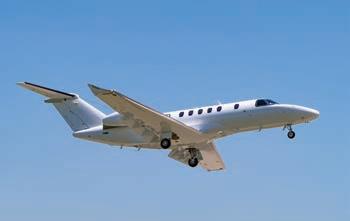
The first production CJ4 Gen3 flew for 3 hours and 29 minutes and reached FL450 last week.
cruise speeds up to 451 ktas, and seating for up to 11 passengers. It includes several enhancements over its predecessor, including Garmin autothrottles, emergency autoland, and a redesigned interior. A.W.
By Sarah Rose
Switzerland-based Global Jet reported continued growth across its core business lines, with developments in aircraft management, charter, sales, and regional operations. “We’re proud to see strong momentum across every segment,” said Matteo Betancourt, the company’s business development executive. “It reflects our strategic investments and close alignment with evolving client needs.”
In the last year, Global Jet added more than 17 aircraft to its managed fleet, including a Cessna Citation Latitude; Embraer Praetor 500; Dassault Falcon 900LX; Gulfstream V and three G700s; four Bombardier Global 7500s; and an Airbus ACJ319neo. The company now manages one of the world’s largest Global 7500 fleets and operates multiple aircraft equipped with Starlink satcom. Further
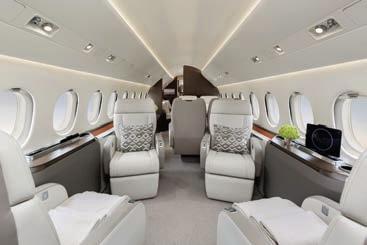
additions expected later this year include two Falcon 6X jets and a Global 8000.
Global Jet’s charter division has also grown, with nine recent additions, including a Falcon 900LX and G650ER. These aircraft bring enhanced range, cabin comfort, and modern connectivity features such as Ka-band satcom, USB-C charging ports, and integrated streaming platforms.
In Spain, Global Jet has added three aircraft to its fleet, expanding service to Madrid, Barcelona, Valencia, Malaga, and Andorra. In the French Riviera, a Citation Latitude joined an existing fleet of largecabin aircraft, supporting demand driven by seasonal tourism.
On the transaction side, Global Jet has completed several aircraft sales, including an ACJ319neo and a Global Express XRS. The company is also managing off-market listings and has been appointed to represent aircraft that include a Falcon 7X, Boeing BBJ1, and ACJ320.
The business aviation market, the company notes, is showing signs of stabilization, with ongoing demand for large-cabin, long-range jets. Global Jet said it remains positioned to meet that demand with a mix of operational expertise and client-focused services. z

By Amy Wilder
As general aviation (GA) traffic increases across Europe, EASA and its partners have introduced two initiatives to reduce the risk of midair collisions. The measures include a voluntary “Conspicuity Declaration” and technical standard known as ADS-B Light (ADSL) to support electronic visibility for GA and drone operations.

Florian Guillermet EASA executive director
Most GA aircraft operate without traditional collision-avoidance systems due to their weight and cost, relying instead on visual separation in
uncontrolled airspace. Advances in technology have made it possible to equip smaller aircraft with lightweight electronic devices that improve situational awareness by making them visible to other pilots and ground stations.
“Every year, there are an average of six fatal airborne collisions involving GA, leading to 13 fatalities,” said EASA executive director Florian Guillermet. “The ability for every pilot to have access to affordable, compatible systems…will be a major step forward in safety.”
Signed by 11 aviation authorities and organizations, the Conspicuity Declaration promotes the use of visibility-enhancing technologies such as ADS-B Out and ADS-L. Signatories have committed to encouraging their adoption and to sharing data to inform future safety strategies.
The accompanying ADS-L Coalition focuses on technical coordination, with industry participants pledging to support ADS-L integration into current and future avionics. By standardizing these systems, the initiative aims to improve interoperability and increase adoption across Europe’s diverse GA sector.
Both efforts support EASA’s GA Flightpath 2030+ strategy, which emphasizes a safer, more connected future for general aviation. Preventing airborne collisions remains a core goal in both EASA’s Annual Safety Review and the European Plan for Aviation Safety.
“These actions will help ensure a thriving GA community, which is vital for the whole aviation ecosystem,” Guillermet said. z
Euro Jet has expanded its ground handling capabilities across the Baltic region, adding personnel in airports throughout Estonia, Latvia, and Lithuania as part of a strategic growth initiative, while simultaneously preparing for increased summer tra c along the Adriatic coast.
The flight support provider has deployed additional representatives in the Estonian capital of Tallinn and at regional facilities including Tartu, Parnu, and Amari. Similar sta ng expansions have taken place in Latvia’s Riga hub and across Lithuania’s three busiest aviation centers—Vilnius, Kaunas, and Palanga.
According to the company, the enhanced Baltic presence aims to serve flight segments including business, diplomatic, humanitarian, and military operations. The team there operates under Katarzyna Kopanska, Euro Jet’s manager for the Baltic region.
“Our new agents bring extensive experience in aviation, and we are confident that Euro Jet will attract new clients and strengthen our position in the region. Their expertise and connections will help us further enhance
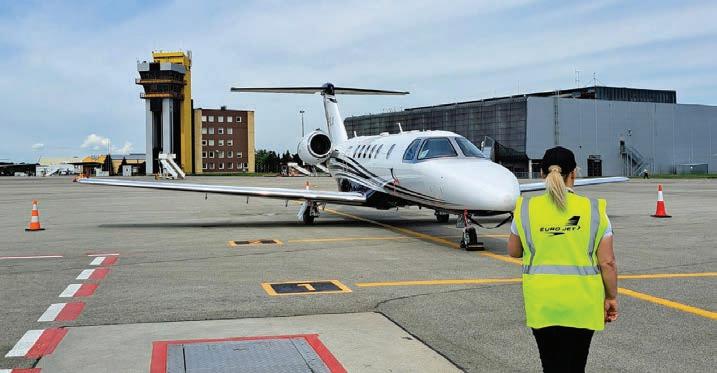
Euro Jet has added personnel at airports where it provides ground handling services.
service quality and operational e ciency,” Kopanska said.
The Baltic expansion coincides with Euro Jet’s preparations for what it expects to be a high-volume summer season throughout popular vacation destinations in Croatia, Montenegro, and Albania.
Services available across both regions include traditional ground handling, fuel
coordination, permit acquisition, catering arrangements, and crew accommodations.
Euro Jet maintains dedicated ramp vehicles and crew lounges at busier Balkan airports. During peak periods, the company also o ers alternate parking solutions.
Euro Jet is showcasing its expanded service network this week at EBACE in Geneva; the company is also sponsoring the event. J.R.
By Charles Alcock
AMAC Aerospace acquired aircraft modifications specialist Kreative Engineering Services (KES) on the cusp of EBACE. The transaction—completed on Thursday—adds cabin design and modification capability to the group’s portfolio, as well as increased bandwidth for advanced engineering projects, EASA/FAA certification and compliance tasks, and product development and industrialization for furnishings and mechanical systems.
KES, was founded in 2012 and is based at L’Isle-Jourdain in southwestern France. It has extensive experience working on the design and modification of interiors for VIP and commercial aircraft.
Meanwhile, AMAC’s facility in Basel, Switzerland, is busy most of the time, but the maintenance, repair and overhaul (MRO) specialist outdid itself recently when it had five VIP Boeing 747s on its hands smultaneously. The tasks conducted on the widebodies included a mix of 6A, A, B1, B2, C1, C3 and D checks; 12-, 24-, 36-, and 48-month checks; and the installation of a Starlink communications system.
The 747s were parked on AMAC’s 695,456-sq-ft apron outside a five hangar-complex, which offers 356,608 sq ft of covered space, as well as 72,161 sq ft of workshops. According to the company, this extensive real estate provides flexibility to work on multiple large aircraft at the same time, while also providing faster turnarounds on projects and quicker response times.
In addition, AMAC recently completed repairs to 53 cracks found during a maintenance check in the stringers of a Boeing 7478i. The repairs were carefully coordinated with the manufacturer and the company has already finalized a second stringer repair project kit for another 747-8i with the same problem.
AMAC also supports midsize and largecabin business jets. The company has been increasingly in demand for maintenance and refurbishment work on various Bombardier
types, supporting customers in Africa and India following aircraft transactions.
The scope of work includes pre-purchase inspections and installation of connectivity systems. According to AMAC, the volume of business aircraft transactions is set to grow by around 30% this year, prompting increased demand for pre-buy inspections.
Over the past six months, AMAC’s engineers have rising numbers of satellite communications installations. Work has covered more than 50 Ka-/Ku-band systems and several projects involving low-earth orbit constellations.
Expansion work to the engineering building at EuroAirport in Basel has now been completed, having begun in September 2024. By this summer, all technical departments will have completed relocating into the new 44,132-sq-ft facility.
AMAC has also completed an upgrade to its design studio, which now has more space for a growing team of designers. The group led by Christelle Dietsch, the company’s interior design manager, includes a color, material, and finish designer; technical designer; junior aircraft interior designer; and interior design assistant.
The design team works closely with aircraft owners and operators to understand their needs and expectations for projects. These conversations help to formulate detailed design packages covering all aspects of the cabin interior work, including color schemes, finishes, and mood, alongside technical constraints and feasibility.
According to AMAC, it has completed maintenance work on more than 50 widebody aircraft, 120 narrowbodies, and 250 midsize business jets over the past 12 months. To keep up, the company has recruited more than 80 new technicians to work at its Basel facility.
Since joining the Airbus Corporate Jets service center network in December, AMAC’s team in Basel has been working on multiple aircraft during the first five months of this year. The partnership was announced in December at MEBAA, and the company said it now wants to expand the scope of its work for ACJ operators.
In Turkey, AMAC’s base at Bodrum has also been busy, with recent projects including the redelivery of an Airbus A330, which was one of five of this type supported in conjunction with the group’s Basel facility. Over the past 12 months, the Turkish facility has completed work on more than 20 Boeing and Airbus narrowbodies, plus around 10 widebodies, with the Bodrum team completing 95% of maintenance checks on time.
AMAC’s facility in Istanbul supports business aircraft including the Dassault Falcon 2000, 900, and 7X, as well as Pilatus models. Over the past year, projects have included C checks on multiple Falcons. z
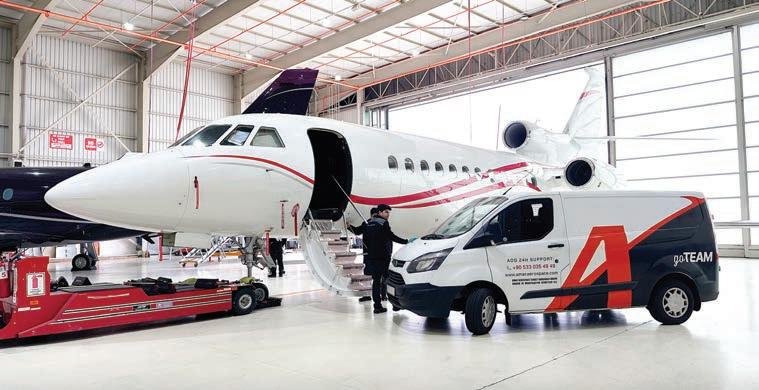
By Curt Epstein
Even though the RefuelEU sustainable aviation fuel (SAF) mandate took effect on January 1, there is still some confusion on the process, according to Titan Aviation Fuels International CEO Daniel Koetzer.
“We understand that the RefuelEU mandate is aiming to help the environment, which is important, but it is not a one-size-fits-all regulation,” he noted. “It’s just the way it was put together, I think everything was not thought out very well. As with any new project, there are always hiccups in it.”
The mandate requires in-scope aircraft operators (those who fly more than 500 flights a year) to upload a 2% SAF blend at designated European airports—generally those with larger volumes of operations—with
UAS International Trip Support has unveiled a charter concierge program that can be adapted to customers’ travel needs. Announced on the eve of EBACE, the UAS Charter Air Concierge program will provide priority access to aircraft and 24/7 personalized support with a dedicated key account manager who will arrange all details of a trip. Other benefits include paying only for time airborne, from takeo to landing. The air charter program does not include taxi time in assessing charges. In addition, there are no extra fees for last-minute booking requests, and friends and family can have access to member hours and services. UAS is o ering a range of packages. K.L.
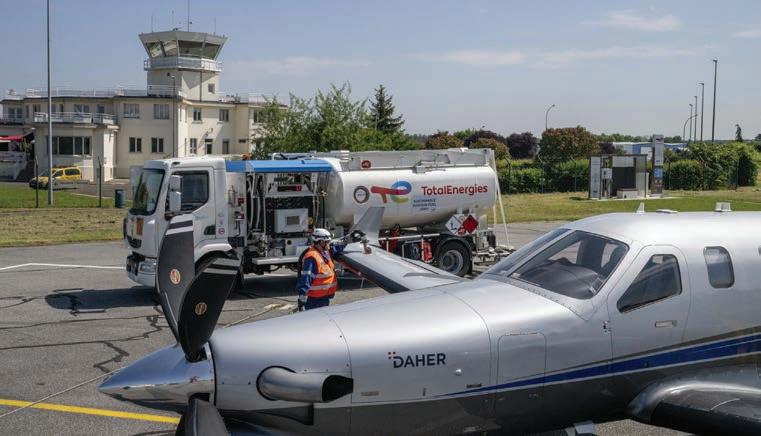
RefuelEU took effect in January, but many in business aviation remain confused by the mandate, which requires in-scope aircraft operators to buy 2% SAF blended fuels.
the exception of those in Switzerland, which declined to participate in the program.
“The big issue here is that you end up with people who are out of scope, who are not on the list, but the [airport fuel] suppliers are charging everybody,” said Koetzer, adding someone has to pay for the increased fuel blend cost. “I understand the point in the sense that at the airports where there is SAF, they have a tank and they put 2% of the product molecules in there.”
Koetzer noted that currently there is no mechanism for those who are erroneously charged the 2% SAF surcharge to be able to reclaim it. “We’ve spoken to [EBAA headquarters in] Brussels, and we continue to talk to them,” Koetzer said. “I think they will be working on a reclaim process if I have paid it, but don’t have to pay—like VAT.”
For the airlines, which are by definition in-scope, those extra costs can easily be amortized across a passenger load, but the economics of private aviation do not correspond, leading to disproportionate costs for charter operators. “For a guy with a Citation or a Gulfstream V who is filling up his tank, that 2% is rough for him, and there is only one or two passengers in the airplane paying for it, so it’s a bit different,” Koetzer explained.
SAF still only accounts for a minute percentage of the overall aviation fuel supply and, due to that scarcity, Koetzer noted operators are also being charged for SAF even at some airports that do not have it. “There’s not enough product, the
airport is too small to justify taking it, just that type of thing, and there is no SAF, but they still charge the 2%,” Koetzer told AIN. “I think [the regulators] are really taking money out of [the out-of-scope operators] pockets because they pay for the RefuelEU, which they are not supposed to pay but they have no real option…in the worst cases they must pay for it where they don’t even get the product. So I think it’s really unfair for these guys, but that’s just the way it works.”
According to Koetzer, one unintended effect of the mandate is a lessening of the appetite among European business aviation operators to take on and pay for higher blends of SAF where it is available. “I think that demand is falling off because people are fueling and having 2% at all their locations,” he said. “Everyone says, ‘Look at my invoices, I have SAF 2% fee that I pay with all my uploads.’” Titan has taken the step to clearly itemize the 2% surcharge on its customer invoices so they can easily consolidate their RefuelEU charges for reporting purposes.
As it helps its clients achieve regulatory compliance, the company is monitoring which airports must supply the 2% SAF blend and is assisting its out-of-scope customers by offering them options where the mandate is not in effect. “We are noting changes in European flight paths as these operators fly to a different airport to avoid incurring extra fees,” Koetzer observed. “An airport like Cannes is suddenly picking up a lot of traffic from Nice.” z
By Kerry Lynch
The Irish Business & General Aviation Association (IBGAA) is gearing up for its next conference later this year, building on the 2024 event that drew 160 delegates. IBGAA is planning its 2025 International Business Aviation Conference on November 13 at the K-Club Hotel and Golf Resort in County Kildare. That was also the site of the 2024 event, which proved popular among attendees, according to IBGAA
Its event attracts leading decision makers and will delve into topics such as doing business in Ireland, obtaining an Irish air operator certificate, and placing aircraft on the Irish registry. In addition, participants will get an update on planning for the Ryder Cup, which will be held at Adare Manor in County Limerick in 2027.
The conference comes as business aviation continues to strengthen in Ireland. IBGAA pointed out that 50% of the world’s commercial aircraft are owned by Irish lessors. Many business jet owners have also selected Ireland for its favorable tax regime and legal framework, particularly surrounding aircraft leasing and ownership structures, according to IBGAA.
Since its founding in 2021, IBGAA has spearheaded campaigns to elevate the importance of business aviation in Ireland, including working to ensure that business aircraft operators would retain slots at Dublin when officials had contemplated a complete ban. IBGAA also worked to educate the Irish government and stakeholders on the economic contribution that the sector provides to the country.
Returning to EBACE, IBGAA founding executive director Joe Buckley will join a panel at

1:30 p.m. today at the EBAA AirOps stage for a session entitled “Securing Airport Access for Business Aviation: Challenges and Solutions.”
Additionally, IBGAA founding member Keith
McKay will discuss business aviation perceptions and the role associations can play for their members in a panel hosted by UAS International Trip Support today at 1 p.m. at Stand 1473. z

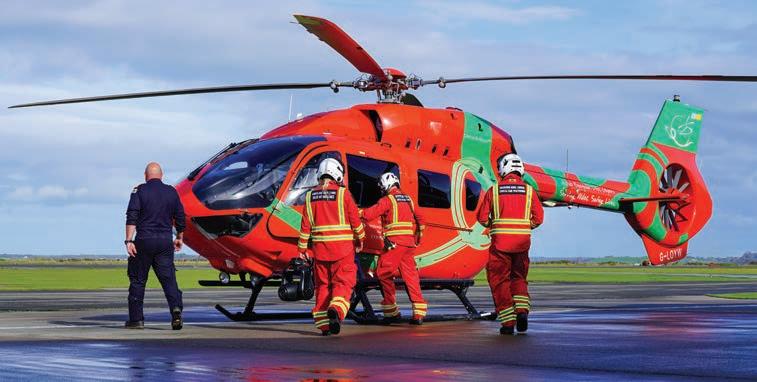
By Charles Alcock
Almost 12 months on from its delisting from the London Stock Exchange, Gama Aviation seems to be relishing its newfound independence with a wave of investments across its business aviation services portfolio. The UK-based group’s chief executive, Marwan Khalek, told reporters during a pre-EBACE briefing that more than $200 million is already committed for projects that include its new FBO complex at Sharjah International Airport (OMSJ) in the UAE and an expansion and modernization of its facility at Jersey Airport (EGJJ) in the Channel Islands.
Much of the capital momentum for the recalibration of Gama Aviation’s business model came from the November 2023 sale of its U.S. maintenance, repair, and overhaul (MRO) subsidiary, Jet East, to West Star Aviation. Now the company is striving to expand its revenues from MRO work conducted for other aircraft operators through the 21 type approvals it holds at its main engineering base in Bournemouth, UK, and at several other facilities.
Gama Aviation recently expanded its mobile service team with an additional hub at London Luton Airport, which is now supporting around 1,500 aircraft a year. It is also adding support capacity in the Middle East and Europe.
According to Khalek, the Sharjah facility is expected to open fully during the third quarter and is backed by an investment of around $70 million. He said the less-crowded airport offers an attractive alternative to Dubai International Airport (OMDB), where business aircraft operators now struggle to get access. The company believes Sharjah, which has a dedicated terminal and hangar, offers better access to the center of Dubai than the more remote Dubai Al Maktoum International Airport (OMDW).
In addition to the facility at Jersey, where the new investment totals $25 million, Gama Aviation also has an FBO at Glasgow in Scotland. “We’re not followers in this industry; we try to take responsibility for growing the size of the market by adding complementary businesses, like Sharjah,” Khalek commented.
Gama Aviation is also seeking to differentiate itself in the aircraft management and charter market, where it plans to provide a boutique service for a select group of clients. To add to the air operator certificates it holds in the UK, the UAE, and the Cayman Islands, last year the company acquired Tyrolean Jets and Services to add European Union-based AOCs in Austria and Malta, as well as one for San Marino.
According to Graham Williamson, managing
director of Gama’s charter management business, his team aims to operate between 40 and 50 aircraft, including a mix of five or so types, to achieve economies of scale. “We position ourselves between larger operators like VistaJet and Luxaviation and smaller operators,” he said. “We’re focused on customers who want a very personal level of service and are willing to pay for it. We won’t be the cheapest, and this is mainly a referral business.”
Williamson told AIN that price fluctuation in the charter sector, in part due to overcapacity of aircraft in Europe, has reinforced Gama Aviation’s intention to be more selective in the bookings it seeks. Its focus is on high-value flights where its ability to respond quickly in challenging circumstances is a service differentiator, such as providing transport for prominent music industry performers on tour.
Gama Aviation’s special missions business encompasses air medical emergency flight operations contracts across the UK. It has increased its support for the offshore oil and gas sector through a joint venture with Bond Helicopters, operating in the North Sea from Norwich. The unit also serves various branches of the UK military, such as providing maintenance for the Royal Air Force’s Beechcraft King Air fleet.
The special missions group is expanding its involvement in drone detection and mitigation services based on counter-uncrewed air systems (CUAS) technology. Working with partners such as mobile rotorcraft operations support provider Helipad, Gama Aviation has provided support at major public events such as the annual Cheltenham Gold Cup horse racing meeting, where it intercepted a drone that threatened the safety of VIP flights.
Ryan McGrath, Gama Aviation’s security manager, said his team will be providing CUAS protection at events such as this summer’s British Grand Prix at Silverstone. The group is also set to participate in a demonstration exercise for NATO militaries in Germany this October.
Additionally, Gama Aviation is expanding its software-as-a-service portfolio, with its presence in the U.S. market significantly bolstered by demand for its MyAirOps software, which has been developed mainly with corporate flight departments in mind. z
By Kerry Lynch
Under new leadership, the African Business Aviation Association (AfBAA) is taking on a busy agenda to expand its reach throughout Africa and more formally structure the organization.
AfBAA confirmed Krimson Aviation founder, chairman, and CEO Dawit Lemma as the chair of the organization and Craig Middleton as vice chair, effective yesterday, with the departure of Bestfly co-founder and executive director Alcinda Pereira on May 1. Also, the association outlined plans to renew the association’s mission, vision, and goals as it seeks to work with 40 different civil aviation authorities across the continent and represent a range of aviation operations and diverse membership.
“We know our members rely on us to lobby on their behalf, identify common issues that need resolving, and act as a single voice with regulators, industry, and international organizations, so identifying the main concerns and creating a strategy to resolve them is at the top of our list,” the association said.
Lemma, who has been involved with the association since its inception in 2012, told AIN that his plans aren’t necessarily to reinvent the wheel—several initiatives had previously been in the works—but to reenergize the association.
These efforts come as the association strives to rebound after Covid. Membership had fallen from roughly 150 before the pandemic to 50 now, as many smaller companies went out of business or struggled financially, Lemma noted.
“We had all the big names, everybody who was anybody. However, there were not many Africans. That’s something I’d like to change. I’d like to see more Africans.” It came down to the fact that it was cost-prohibitive for struggling companies.
“You have to realize that a membership fee can be a person’s salary, so you have to have context and structure the membership fees and everything else, such as attending a conference, so that the cost is relevant.”
According to Lemma, one of the key initial steps under the new leadership is creating a governance committee that will be run by a professional secretariat and define essential processes for a streamlined environmental, social, and government policy.
“We never had a governance committee, I think it’s something that you need,” Lemma said. “It’s not just about your bylaws and your governing documents, but it’s about being responsible socially, environmentally, and having a real purpose—who we are, what we are accomplishing, and why we are accomplishing it. Integrity is one of the key elements of governance.”
The board also plans to reach out to members to establish what they want to focus on and is building on its existing committees, bringing back dormant ones, and creating new ones. These committees will focus on areas such as training, safety management, workforce, operations, and infrastructure improvement.
In addition, AfBAA is planning to step up marketing and communications activity. “AfBAA has been relatively quiet on this front, and we want to build momentum again by raising the profile, adding new AfBAA events, and showcasing the benefits of doing business with African aviation companies,” Middleton said.
AfBAA is introducing North, South, East, and West chapters to enable members to have closer ties with the association as it looks to strengthen communications with its membership and draw in new members. “We are a huge continent, and with these cardinal chapters, we can learn, share, and evolve business aviation together as we meet these differing regions’ needs,” he added.
This was a concept previously launched in the 2016 to 2017 timeframe, starting in Ethiopia, which had its own events and membership. But because the association can’t have 54 chapters, Lemma said he believes regional chapters may be more effective.
“Each region has its own nuances. It’s difficult
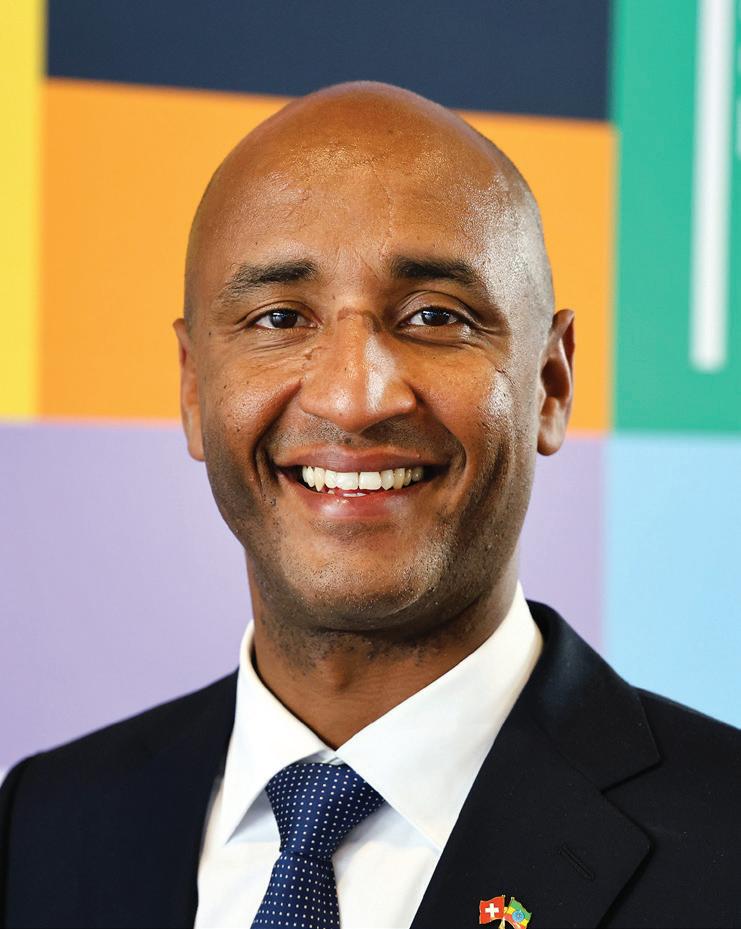
Krimson Aviation founder, chairman, and CEO Dawit Lemma is now chair of AfBAA.
to be representative for the whole continent if you don’t have a regional context and regional representation,” he said.
Lemma is hoping to capitalize on his own multicultural background to expand the organization globally. Born in Ethiopia, he grew up in Zambia and Geneva, and was educated in the U.S.
A licensed pilot and mechanic with multiple international ratings, he returned to Ethiopia more than a dozen years ago to boost business aviation representation in Africa. “I felt that Africa needed more experience in business aviation,” he said. “Outside of South Africa, Northern Africa, and Nigeria, it’s very unknown. Ethiopia is the prime example with a well-recognized global airline, but with no idea of what business aviation was.”
He had already been affiliated with AfBAA but formally joined upon his return to the continent. As he became more involved, he became responsible for events and membership, and eventually as an honorary member and then a full member of the board. He noted how he enjoyed remaining active in the association rather than just attending meetings.
Lemma also became proactive and reached out to international organizations such as IBACE to provide AfBAA with a greater global voice. This is an area he plans to build on, he said. But importantly, he believes this experience, coupled with his knowledge of Africa, helped prepare him for the role of chairman. z
“This consultation is part of a comprehensive review that is ongoing and EBACE25 is a core component in that feedback loop.”
According to EBAA, the planned announcement at the end of next month will resolve details of plans for the 2026 show. Depending on the final choice for the venue, next year’s event is set to be held in either the last week of May or the first week of June.
“One thing remains clear to us: the industry needs EBACE and it remains the right place to meet the right people in business aviation,” Krahmer said. “I’m pleased to share that, depending on the final venue selection, EBACE 2026 will be held either in the last week of May or the first week of June 2026.”
Meanwhile, on Thursday, the organizers of the Aero show in Friedrichshafen, Germany, announced plans to expand the business aviation static display for its next event, to be held April 22 to 25, 2026. The dedicated display, which was introduced for Aero Friedrichshafen 2025 held last month, will have more space next year for business aircraft at the site, which adjoins Friedrichshafen Airport on the northern shore of Lake Constance.
“The outstanding results and positive feedback from the previous event serve both as motivation and a mandate for us to take the next step together with the industry,” said Aero Friedrichshafen director Tobias Bretzel. “Our goal is to further develop the Aero Business Aviation Show Hub in both quality and scale. In addition, we are already working with partners from the charter sector to offer flight connections to Friedrichshafen during the week of the show.”
More than 320 aircraft in total were part of the line up for Aero Friedrichshafen 2025, which featured 760 exhibitors from 38 countries. In addition to business jets, these also include a wide array of general aviation models, helicopters, and drones, as well as multiple examples of advanced air mobility projects. z
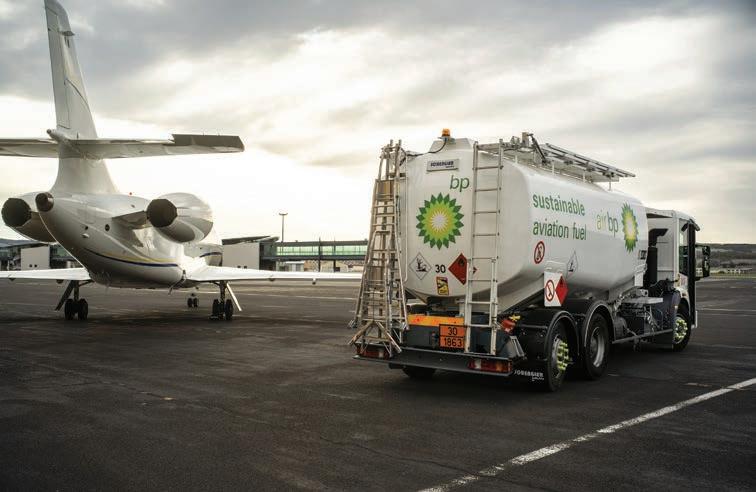
Per
By Charles Alcock
Sustainable aviation fuel (SAF) is now available at more than 100 locations verified by 4Air, which supports business aircraft operators in their efforts to decarbonize. The company announced the milestone yesterday by adding the approved locations to its “Where to Find SAF” online map.
As SAF supplies increase based on the use of a diverse range of feedstocks and with different blends, 4Air takes responsibility for documenting their provenance. The company’s Assure SAF Registry helps customers track and verify their fuel usage to support both voluntary and regulatory claims. Operators need to have the correct documentation for environmental reporting and to demonstrate their commitment to reducing carbon.
According to 4Air COO Nancy Bsales, the number of verified SAF outlets has increased from fewer than 20 locations in 2021, when the company launched the map, to 114 by April. Fifty locations were added to the map
last year, with another 15 following in the first quarter. The 114 locations cover 92 airports, including 47 in the U.S., 43 in Europe, one in Asia and one in the Middle East.
Among the many ground support companies represented among 4Air’s verified SAF suppliers are FBO groups Clay Lacy Aviation, Signature Aviation, Jet Aviation, and Avfuel. On the eve of EBACE 2025, all of these companies said they are committed to achieving further growth in the fuel availability network.
“The expansion of SAF availability is an important milestone for the industry and ensures decarbonization solutions to a greater number of aircraft operators,” said 4Air president Kennedy Ricci. “Our goal is to empower operators to embrace sustainability through tools like the SAF map and services like the Assure SAF Registry.”
4Air supports business aviation companies in meeting their various environmental obligations covered by legislation such as the RefuelEU program and emissions trading schemes. It also arranges approved carbon offset and removal services. z
15 - 17, 2025

“The AIN CALS event has been a refreshing experience for leaders within the corporate aviation community and the vendors that support their businesses. 100% engagement for 2.5 days. Truly a working event that leaves us all a bit tired but very enthused!”
2024
“The AIN CALS event provides excellent opportunities for high level interaction between vendors and clients. The one-on-one time and small group sessions are very valuable settings.”
– 2024 CALS SPONSOR

We’re committed to staying your #1 choice. Our service-made-easy approach means delivering personalized care, seamless convenience, and the confdence to perform.
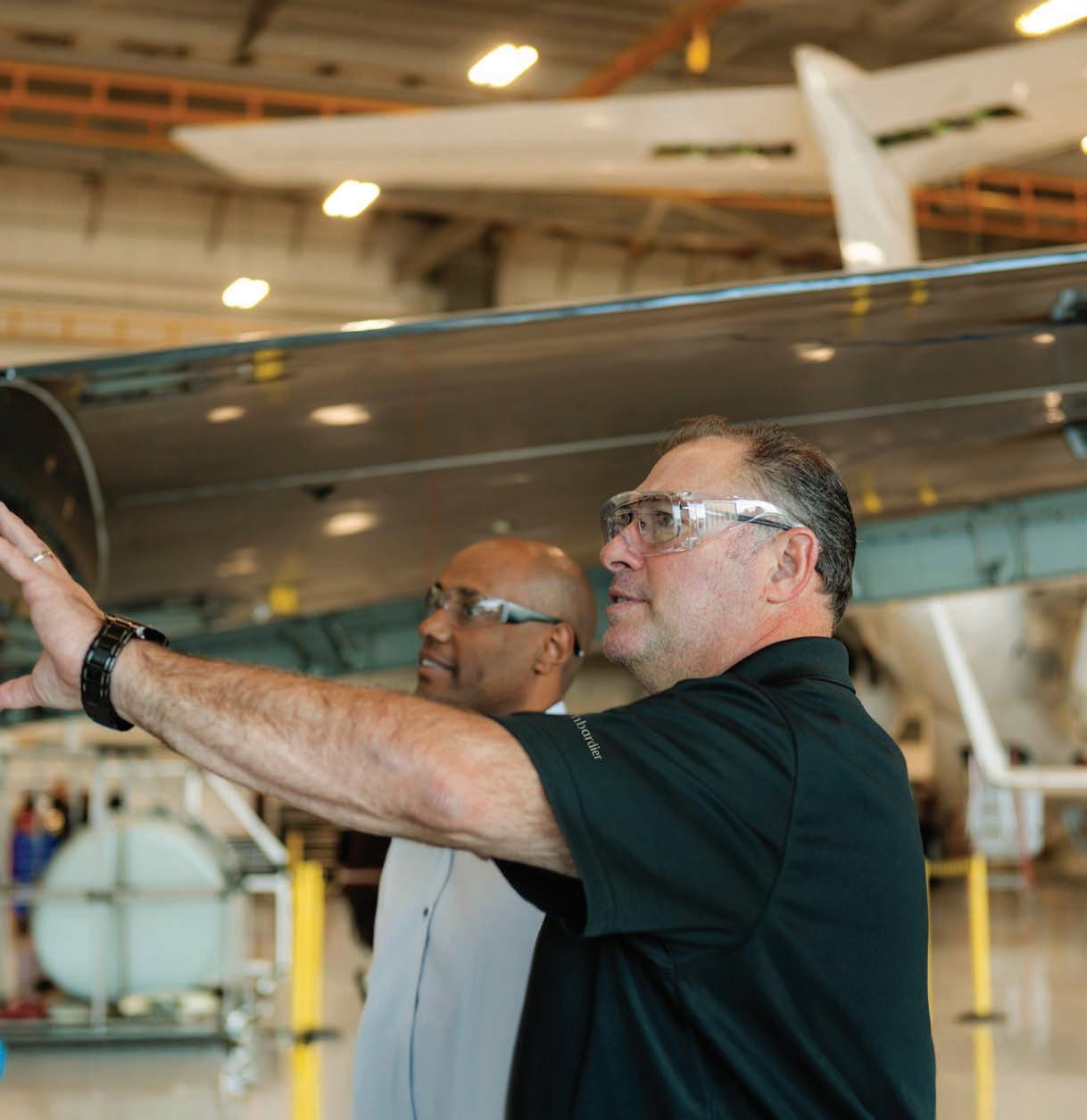




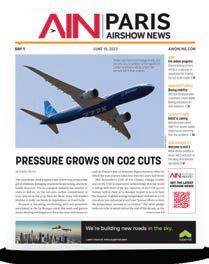



We’re committed to staying your #1 choice. Our service-made-easy approach means delivering personalized care, seamless convenience, and the confdence to perform.

